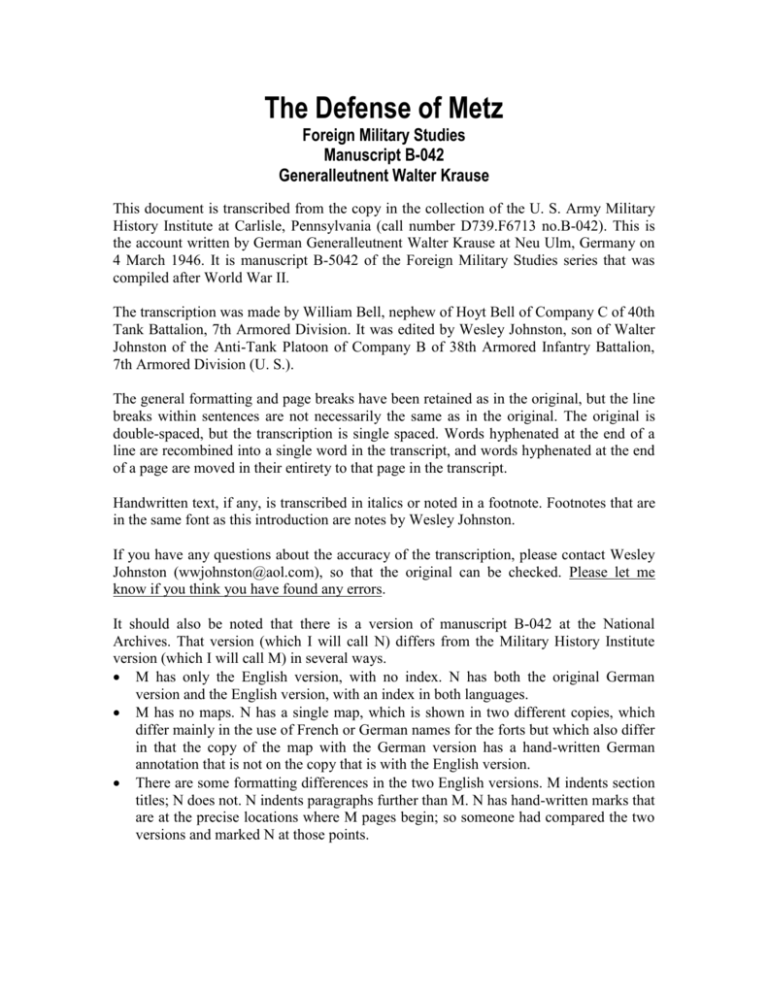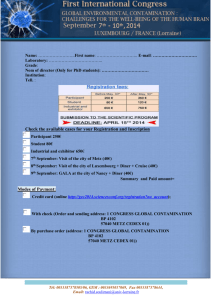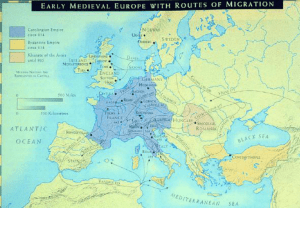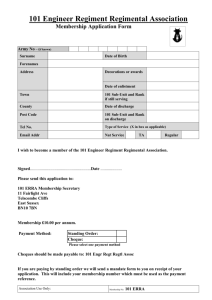Defense of Metz, 1-8 September 1944
advertisement

The Defense of Metz Foreign Military Studies Manuscript B-042 Generalleutnent Walter Krause This document is transcribed from the copy in the collection of the U. S. Army Military History Institute at Carlisle, Pennsylvania (call number D739.F6713 no.B-042). This is the account written by German Generalleutnent Walter Krause at Neu Ulm, Germany on 4 March 1946. It is manuscript B-5042 of the Foreign Military Studies series that was compiled after World War II. The transcription was made by William Bell, nephew of Hoyt Bell of Company C of 40th Tank Battalion, 7th Armored Division. It was edited by Wesley Johnston, son of Walter Johnston of the Anti-Tank Platoon of Company B of 38th Armored Infantry Battalion, 7th Armored Division (U. S.). The general formatting and page breaks have been retained as in the original, but the line breaks within sentences are not necessarily the same as in the original. The original is double-spaced, but the transcription is single spaced. Words hyphenated at the end of a line are recombined into a single word in the transcript, and words hyphenated at the end of a page are moved in their entirety to that page in the transcript. Handwritten text, if any, is transcribed in italics or noted in a footnote. Footnotes that are in the same font as this introduction are notes by Wesley Johnston. If you have any questions about the accuracy of the transcription, please contact Wesley Johnston (wwjohnston@aol.com), so that the original can be checked. Please let me know if you think you have found any errors. It should also be noted that there is a version of manuscript B-042 at the National Archives. That version (which I will call N) differs from the Military History Institute version (which I will call M) in several ways. M has only the English version, with no index. N has both the original German version and the English version, with an index in both languages. M has no maps. N has a single map, which is shown in two different copies, which differ mainly in the use of French or German names for the forts but which also differ in that the copy of the map with the German version has a hand-written German annotation that is not on the copy that is with the English version. There are some formatting differences in the two English versions. M indents section titles; N does not. N indents paragraphs further than M. N has hand-written marks that are at the precise locations where M pages begin; so someone had compared the two versions and marked N at those points. Capture of 3d Cavalry Group Commander, Col. Drury The events described in the first contact at the perimeter with American troops on page 11 of the manuscript relate to the 3d Cavalry Group, which was commanded by Col. Frederick W. Drury. The reports of 3CG show that Col. Drury failed to return from a reconnaissance mission on 5 September 1944 and that his Executive Officer then assumed command until 12 September 1944, when a new commander was assigned. There are two narratives about these events in the combat interviews of the 3d Cavalry Group, which are in National Archives Record Group 407, Box 24106 (Combat Interviews, 3rd and 4th Cavalry Groups), Folder 321 (Metz Operations). “On 5 Sep 44, Colonel Frederick W. Drury, the Group Commander, was accompanying a platoon of Troop A, 3d Cav Rcn Sq, on a reconnaissance mission between Rezonville and Gravelotte. The formation from head of platoon column to rear was as follows: Platoon Leader's (Lieutenant Eddy) Armored Car, Section Sergeant's Armored Car, Colonel Drury's onequarter ton truck and three one-quarter ton trucks of the platoon. At 1400 the platoon was moving and had reached a draw three hundred yards west of Gravelotte when it came under heavy small arms and machine gun fire from the woods 150 yards to the south of the road. The armored cars of the Platoon returned the fire and continued forward towards Gravelotte. Colonel Drury's vehicle and the three following vehicles were seen to stop and all personnel take cover in a deep ditch to the north of the road. When the platoon leader realized what had happened, he made a circuit to the north of the road utilizing a small trail and returned to the high ground in the vicinity of Rezonville to cover the withdrawal of the dismounted party. He was able to observe no one in the ditch about 1000 yards to his front.” “On the 5th the 2nd plat of A Troop was to go from Mars La Tour thru to Metz if possible. The plat was lead by 2d Lt P S Eddy. Col Drury learned the mission at the last minute, at Mars la Tour. On this mission Lt A/C [armored car] led, then the MG bantum, followed by Col Drury with his three bantums, then the S/SGTs A/C, bantums and followed by the sec sgt in his A/C. The column went through Vionville and was going on to Rezonville. Two germans were found on the road and picked up. They said they were walking to Grevelote and when asked if there were any more germans around said no. When asked about mines, they couldn't make up their minds. Lt Eddy consulted Col Drury, and he said carry on. Lt Eddy then put the two germans on his A/C, one over each front wheel. Coming out of Rezonville to Gravelote, there is a draw crossing the road, a bridge at the bottom of the draw, and then a hill covered with heavy woods. The Column started down into the draw. Saw some germans along the ditch at the bottom, but they turned into the woods. The column kept moving and began coming up the hill. Then they saw a couple of eny to the right, on the right of the woods. The german over the left wheel jumped off at that point and he was shot while trying to get away. Then Mortar fire beagan coming in from the right while the 1st A/C was half way up the hill. About 200 yds off eny could be seen in the bushes. The column stopped. The bantum went for the ditches and the men dis mounted, while SA fire came in from both sides. Artillery was beginning to fall, first fairly light and later heavier, Lt Eddy saw he couldn't turn around, so barreled his A/C on thru his S/Sgt pulled out around the bantums in front of this and followed. While the section Sgt backed his A/C out. Just after the 2nd A/C passed the eny blew a rd crater completely blocking the rd. The two A/C went on to the top of the hill, turned to the left behind the woods, pushed thru some open country and circled back to Rezonville without being shot at. Checking with the section Sgt found there were only 3 bantums that had followed him back. The three bantums with Col Drury were still in the draw.” The volume (“The Lorraine Campaign” by Hugh M. Cole) of the official U. S. Army history of World War II mentions the action (p. 120): “In one brush with the Germans near Gravelotte, the commanding officer of the 3d Cavalry Group, Colonel Drury, was ambushed and captured.” The troops of the Fahnenjunkerschule (Officer Candidate School) captured Col. Drury. Their report was found in Metz after the city was eventually taken. It is now in National Archives Record Group 407, Box 24082 (Combat Interviews), Folder 246. The underlining is as in the original. “On 5 September 1944, the first advance of American tank spearheads from Rezonville to Gravelotte in strength of two Armored Reconnaissance cars, four jeeps, and three Sherman tanks. The first two armored cars are allowed to pass, as ordered in our plans, then the road is blown up and we opened fire. The crew of the jeeps are jumping off the vehicles, under protection of the three tanks, and go into position on both sides of the road. Two squads of 1st Lt Henneberg attack the Americans and take nine prisoners, among them one colonel. Two tanks are destroyed by the officer candidates Norkus and Lorenz with Panzerfaust. The colonel, the commanding officer of the 3d American Cavalry Regiment, being visibly impressed and despondent, stated, when later interrogated: ‘I never saw anything like that from German soldiers, who attacked us from all sides.’” MS # B-042 -1- D E F E N S E O F M E T Z. (1 - 8 Sep 1944) Preceding History. All reference material is lacking, consequently inaccuracy is to be expected, in regard to dates in the material in the following report. All details pertaining to dates, therefore, are of an approximate character and are not to be relied upon as literally correct. The above concerns the entire report. On or about 20 Jul 1944, I was appointed as Commanding Officer of the 462d Division (a training division). Replacements and training battalions that were under the jurisdiction of this division were stationed in Lorraine and Luxemburg; the staff in Metz. It was under the immediate command of the acting XII General Command in Wiesbaden (Commanding General: Lieut. Gen. of the Infantry SCHROTH). Duties and responsibilities of the division consisted of: the training of new replacements, reorientation of newly recovered soldierpatients, training of non-commissioned officers, and care of released sick unfit for combat, until their discharge from the Wehrmacht. These units were consequently not prepared for combat at the front according to their quality; their training had been directed toward an entirely different aim. Commissioned officers as well as non-commissioned officers, the composite of this training unit, were either physically unfit veterans or over-age personnel. MS # B-042 -2- Their condition, therefore, did not meet the requirements necessary for a combat soldier. At the end of August, from about 22 August onward, the effect of the invasion and of the enemy successes was very noticeable. Increasing numbers of disorganized units and masses of dislocated individuals, as well as vehicles loaded with these elements, arrived from the West. The main contingent of these units consisted of air corps personnel. Ground personnel and signal troops of these units amounted to more than 50% of these rear columns. On or about the 24 August, traffic flooded through Metz uninterruptedly. I was ordered by telephone by the acting XII General Command, to take upon myself the responsibility for maintaining order in Metz and for an efficient processing of retreating columns from the West. The Situation in Metz. Metz was the seat of many Wehrmacht installations, staffs and officers, Waffen SS, officers of the state and the Party. Staffs and Wehrmacht formations eventually to be used to defend the city, and so stationed there, consisted of the following units: a. Wehrmacht. Staff of the 462d Division and two infantry training battalions. One machine gun training unit, one artillery training unit; one engineer training battalion. MS # B-042 -3- The Wehrmacht Headquarters Command, that had, however, only limited control over the Air Corps and none whatever over the Waffen SS. The Officer Candidate School in Metz, strength approximately 1800 Officer candidates with a proportionate number of training personnel, the latter being mostly selected men. Experienced officers whose wounds from combat had healed or were in process of healing. The current course was scheduled to terminate on 1 September. Those candidates who had passed the examination on 1 September were promoted to officer's rank on this date. 1400 of these candidates became lieutenants, and 400 rendered services as (master sergeant) officer candidates. A hospital or dispensary for horses, the occupants of which were mainly unsuited for work. Several medical institutions, munition depots of various kinds, and a large munition plant which had suffered acutely from enemy air attacks. Pertaining to the air corps: Cadets Staff of the airport (under command of general M. MEIR), the staff of an air corps division, and of the Frascaty Airport, which contained large supplies of aircraft parts of all kinds as well as clothing supplies, etc., for the air corps troops engaged on the west front. b. Waffen SS: A signal school, strength of which amounted to 2000 heads, whose commander discharged the duties of Post Commander-in-Chief at the same time. c. The organizations and authorities of the Party and state under the eye of Gauleiter Buerkl (Headquarters in Neustadt on the Haardt stream). They did not participate in defense activities in any way. MS # B-042 -4- In compliance with the responsibilities placed on my shoulders, and as a direct consequence of my appointment, I arranged measures for the welfare of the refugee streams that flowed in from the west. Elements of the field police and border patrol1 units were stationed about 20 km west and south of Metz on the main highways, to check the papers and baggage of the oncoming personnel and vehicles. Personnel of the Wehrmacht meeting the requirements of combat men were selected, and amounted to 10,000 at the start of battle. They were classified in accordance with their previous experience. Approximately 2000 men were allotted to the formations in and around Metz. Essential transportation facilities were just requisitioned as well as all weapons and munitions for the troops in or about Metz. The state of affairs regarding the defense of Metz was as follows at this time: Metz was at one time one of the strongest fortified cities of Germany: During the French occupation, which lasted from 1919 until 1940, the factories had not maintained their defensive qualities, at any rate, they had not been improved since their transfer in 1940 from German to French hands. Also, after their transfer in 1940 to Germany, conditions had not improved. On the contrary, heavy artillery which had been stationed there had been removed and sent to the Atlantic Wall or the so-called West Wall. The fortification works had been neglected, the electric installations in these works for light, ventilation, munition transportation and general power were not in condition for use. I was informed by the 1 The provinces of Alsace and Lorraine had been part of Germany until the end of World War I, when they were made part of France. After the German Army seized the provinces in May 1940 and defeated France, Germany reincorporated them into Germany. Thus the actual border between France and Germany was west of the Moselle River and not in the location that international maps of the time showed. For example, St. Ail had a border crossing station. MS # B-042 -5- Colonel of the Engineers v. Platz, that Metz should be dismantled, as military defense with these fortification works was impossible. This notification proved to be partly unreliable, as reconnaissance units of the Officer Candidate School examined and found that in the southern adjoining battery attached to the "Kronprinz2 Fort number 4, "10 centimeter guns under steel domes could still be made ready for fire. Also the Kaiserin Fort3 contained from 2 to 3, 15 cm guns, the barrels of which could be recovered from the gun carriages. The guns concerned were brought into useable condition after three days of hard labor. Also here the guns proved to be in good combat order after the above measures had been taken. Fuses and grenades as well as shells had been stored outside of Metz, which also caused a delay in our preparations. The guns mentioned, could only go into action after combat engagements with the enemy had begun on 6 September. Sighting devices were wanting on these guns, consequently they could be fired only directly at the enemy. The guns were manned by officer candidates of the school in Metz. The defense of Metz could not be based consequently, on the strength of the permanent works. The Officer Candidate School built some field works in conformity with the requirements of a war of movement. A network of deeply echeloned dug-outs was constructed by these men, as the main form of protection. Barbed wire entanglements could not be constructed owing to lack of necessary materials and time. The available works were used solely as shelter for reserves and field equipment. Explosives to demolish roads and bridges were acquired from any available source and put in place, and the spots from which they would eventually be detonated 2 The map attached to the German-language version shows that Kronprinz was the German name for Fort Driant. 3 Feste Kaiserin was the German name for Fort Jeanne d’Arc. MS # B-042 -6- Occupied. These labors were continued until actual engagements with the enemy commenced, and in some cases the work was brought to completion. The Commanding General, who happened to come to Metz for a few hours on 28 August, expressed his satisfaction in regard to the preparations proceeding and promised us supplementary supplies and replacements. In the meantime, the probability of an enemy attack on Metz, became greater and grew stronger in the ensuing days before 27 August. On this particular day, the enemy reached the Maas River near Verdun and managed to build a small bridgehead there. Communication with the troops engaged there, brought out that our front there only consisted of the very weakened Goetz von Berlichingen SS Division which was not in a position to engage in a defensive battle with much prospect of success. The following units were assigned to the defense of Metz by the end of August, including some troops that were then still on the way up as reliefs which were then (when they did arrive), all subordinated to the 462d Division: 1. The Officer's Candidate Regiment, divided into two battalions with infantry guns and antitank companies. This regiment consisted of about 1500 men withdrawn from the retreating columns and all drawn from all arms of the service. They were poorly armed. Their combat efficiency however rose noticeably after being distributed among the officer candidates, whose influence was very markedly favorable and enhanced their knowledge of warfare. All important posts, such as MS # B-042 -7- Squad-leader (Gruppenfuehrer), gun aimer for heavy weapons and light machineguns, dispatch-riders, etc., were occupied by officers. Equipment, arms, and munition supplies were matters for serious worry. 2. The Replacement Artillery Detachment (which was equipped with Russian 7.5 cannon - each 3 guns), consisted of two battalions. This replacement unit was non-mobile. The horses for them had to be taken from the horse hospital and the harness from the supply depot. The adaption of these animals to their new work was a difficult task. The detachment was ready to march within 36 hours. It was placed under the control of the Candidate Regiment and brought into position in the Gravelotte district. 3. The two infantry replacement battalions, stationed in Metz, were sent into action on both sides of the stream that flows near Noveant and Corny, adjoining the Officer Candidate Regiment. The Replacement Machine Gun Column was placed under the command of the candidate regiment near St Privat. One company of the Replacement Engineer Battalion occupied the Mosel bridges, one company was subordinated to the command of the Candidate Regiment for construction work and preparation of placement of explosive charges in the forward area ahead of the front. One company remained still available. All replacement units weeded out their "undesirable for combat" who were then sent to the rear. The efficiency of those actually sent into action was poor. 4. A security regiment, returning from France (the # 1010, under command of Lt. Col RICHTER) was reorganized and assigned to Metz. It MS # B-042 -8- consisted of two battalions, each of three companies. The total number of men amounted to, from 500 to 600 minus heavy weapons. Each company possessed two light machine guns. The personnel of these units was made up mainly of over-aged men and convalescent veterans, who, under normal circumstances would have been unfit for action. This regiment was assigned to positions located to the south of St. Privat and north of the Feve slopes, their front facing to the north. 5. On or about 29 August, the acting XII General Command Army Corps sent reinforcements: a. The XII Army Corps NCO School (Commander: Colonel WAGNER). These elements amounted to 1500 men, who had attended different courses (Platoon-Leader and Group-Leader courses, courses dedicated to the teaching of knowledge concerning heavy weapons, etc.). The above mentioned men had been enrolled at this school at that time. Due to the fact that it had been alerted for combat and shut down at such short notice, it was impossible to transform its personnel into an efficient fighting unit on the spot and consequently the organization of these troops had to await their arrival in Metz, their position-to-be. Combat value of the NCO regiments was soon good and their efficiency enhanced; that of the Security Regiment was decidedly poor. b. One Replacement Battery, 10.5 cm (4 guns), which was under command of the Candidate Regiment, and who went into position near St. Privat. The action pertaining to a. and b. ended approximately on 31 August. The measures required for the reorganization and MS # B-042 -9- rehabilitation of these units consisted, moreover, of selection of suitable personnel, the construction of dug-outs, etc. These duties were commenced and continued during the entire period of my command. Also here, munition supplies were matters of grave worry. 6. The Antiaircraft Security, formerly stationed in Metz, was also brought into play here against ground targets. Mainly a small number of light batteries are concerned here (2 cm and 3.7 cm ) and one light 8.8 cm detachment. The latter was brought into position in the most threatened section on the front area, in the Gravelotte district. Three antiaircraft detachments were, in spite of my repeated expression of opinion on the subject, selected and sent to the rear to act as security for the supply routes, on 6 September. 7. The Signal School of the Waffen SS assembled one battalion of four companies, which were to act as reserves for the Division -- left behind in Metz. During the course of the combat engagements following, to the south of Metz, it was assigned to the Goetz von Berlichingen Division district and was later absorbed by this division. This meant that it could not assist in the defense of Metz. The units mentioned in subparagraphs 1-6 are those with which I defended Metz. Reinforcements from the field army did not come up. The Beginning of the Battle Around Metz. The enemy, as was mentioned before, reached the Maas River, near Verdun on 27 August. On about the night of 27 August, the 1st Army MS # B-042 -10- High Command (Commander in Chief, General V. D. CHEVALLERIE, of the infantry) arrived in Metz (the Verneville Field Outpost). I reported to him immediately. The result of our conference was: Metz would be subordinated to the 1st Army High Command, and be placed under command of the XLVII Army Corps (the commanding general was General Frhr of the Panzer troops, v. Funck). Our mission was: To hold Metz under all circumstances. Elements of the Goetz v. Berlichingen Division, which were engaged with the enemy west of Metz, were to retreat slowly backward towards Metz. The eventual aim would then be the absorption of the Goetz von Berlichingen Division by the Officer Candidate Regiment, upon its arrival at the extreme western outposts of the above-named regiment. The 462d Division was from now on dependent upon its own strength in the battles around Metz. The Army High Command, first transferred its cp to Longroy. The staff of the XLVII Army Corps, which had arrived in Metz on 28 August, remained the command until about 2 September and was then relieved by the LXXXII Army Corps (Commander: Lieut-Gen of the Artillery SINNHUBER). Metz was declared a fortress town on 2 September and I was appointed its commander and was ordered to hold the city at all costs by General SINNHUBER. The Corps Headquarters transferred the cp to Urville, and was replaced by the staff of the 13th SS Panzer Corps on approximately 6 September (Commander: Lieut-Gen of the Waffen SS PRIESS). I moved to my assigned command post on 3 September in Fort Alvensleben.4 The Officer Candidate Regiment moved to 4 Fort Alvensleben was the German name for Fort Decaen. MS # B-042 -11- Fort Manstein, and the Non-Commissioned Officers Regiment to Fort Zastrow.5 The command of the Moselle Valley near Noveant and Corny was transferred to the Commander of the Replacement Battalion in Noveant. From the point of view of message communication, the connection with the subordinate staffs was completely inadequate. Only very seldom did a long-distance message arrive at its destination. Skilled personnel and the essential materials were lacking. The close location to each other of the Candidate regiments and the Division command post, proved advantageous to the combat leadership. In contrast, reports coming from the Moselle Valley were delayed hours before arriving. The Goetz von Berlichingen Division retreated slowly from the enemy moving out of Verdun, who was not exerting any considerable pressure, eventually to be drawn behind the security front of the Candidate Regiment during the night of 2/3 September. The first enemy activity was detected on 3 September. An enemy reconnaissance group, consisting of from six to eight patrol cars followed by five tanks, rolled forward in the direction of Metz, along the Mars La Tour road. The patrol posts of the Officer Candidate Regiment allowed these vehicles to roll along undisturbed until they had crossed the bridges, then demolished the latter behind them. Fire was opened in the meantime by heavy and light infantry guns. We succeeded in capturing the crews which included a commander of a reconnaissance regiment.6 On about 4 September the enemy started to attack according to a clearly defined plan, first with an armored division, followed immediately by an infantry division, the 5 Fort Manstein was the German name for Fort de Plappeville. Fort Zastrow was the German name for Fort Deroulede. 6 See the section in the introduction on the capture of the commander of the 3d Cavalry Group. MS # B-042 -12- Officer Candidates stronghold east of Metz. Soon heavy battles were going on, especially at St. Privat, near and north of Verneville, near Gravelotte and south of there; in the vicinity of Gorze heavy combat engagements ensued. St. Privat was lost to the enemy next day and the slope defenses, located east of the town were transferred to other positions. The front west of Gravelotte was moved back, owing to the fact that the enemy, apparently informed about the terrain by the natives, consequently succeeded in penetrating our weak defense lines in the wooded district around Rezonville. The front was now located hard east of Gravelotte, almost parallel to the road leading to Ars. Fort Kronprinz in the Moselle Valley and the southwestern exit of Ars were occupied next. This front was held during the period of my command, by Officer Candidate Regiment in spite of heavy attacks by strong American elements. The conduct of the Candidate Regiment was exemplary. They repeatedly threw the enemy back, partly in counterattacks. The only major want was our great shortage of munitions for the artillery. The enemy suffered considerable losses. Approximately 25 American tanks were knocked out, most of them with bazookas, 150 prisoners were taken. The regiment also suffered noticeably. On about 12 September, the fighting on this front began to diminish in fierceness. Heavy battles had been raging here since 8 September, mainly fought by the Non Commissioned Officers Regiment in the northern district. An enemy surprise attack resulted in his penetration into the MS # B-042 -13- Brieye district. During these same engagements, the enemy captured Diedenhofen. From there he attacked west of the Metz road, and Diedenhofen from the north. Heavy attacks followed with the support of heavy armored units. Mazieres was lost after an intense battle. The new cp was held temporarily, despite heavy enemy attacks hard south of Mazieres, one km north of Semecourt and north of Feves. The NCO Regiment fought bravely, although the combat efficiency of the Security Regiment left a lot to be desired. The light Machine Gunner Company was sent to its support. It was taken from the right wing of the Candidate Regiment for this purpose. Despite these measures, critical situations arose here frequently. Reserves of the NCO Regiment were reportedly brought to the rescue. The enemy must have had serious casualties, as became obvious when, on the 15th, the attacks ceased. Ten tanks were knocked out during these engagements. Casualties of the NCO Regiment were bearable. The intensity of the defense put up must have been the reason the enemy attempted to bypass Metz, aiming at a forced crossing over the Moselle, south of the city. After the NCO Regiment had switched its front defense line to the Kronprinz fort and had bent it back toward Ars, the enemy concentrated his powers on Gorze and aimed toward Dornot, launching a surprise attack on 7 September, with strong assault troops, resulting in the crossing of the Moselle to the East. Meanwhile, enemy elements were pushing forwards to Noveant. The Replacement MS # B-042 -14- Battalion which was defending here held out one day and was then ferried to the right Moselle bank. The enemy, crossing near Dornot, ran into nothing but single sentries on the right bank. These did not, of course, succeed in throwing his assault troops back. The enemy was reinforced during the night with approximately one battalion, which pushed forward in the direction of the Haesele fort7, easily overcame the weak security left behind by the replacement battalion, which had already been withdrawn and took the fort. It had not been allotted any security, owing to scarcity of reserves. This dent in our ranks caused by the enemy's latest moves was a serious menace to the whole front. The weakened occupation of the fort in Mazieres could not possibly stand up to him at this place, he outnumbered us greatly. Consequently, on 8 September, two SS Battalions of the Goetz von Berlichtingen Division were brought to the scene with their artillery. These troops had been farther to the rear formerly. Despite of heavy artillery counter action on the west bank, the latter troops succeeded in recovering the Haesele Fort. The enemy was forced to withdraw from the eastern bank on 9 September. The entire front on this bank was now withdrawn from the control of the 462d Division Command and was placed under command of the Goetz von Berlichingen SS Division. In addition to the serious shortage of personnel, also the supply lines for artillery ammunition were greatly hampered by blockage of the 7 Feste Hässler was the German name for Fort Verdun. MS # B-042 -15- lines. For example, on 7 September, early in the morning, a column of American bridge building pioneers8 were sighted in the northwest. The vehicles could be counted distinctly but we could not open fire on them for lack of artillery munition. This occurred on the road to Dornot. The Kronprinz Fortress battery adjoining, however, took a hand for the first time in the fighting against Dornot. The result was fruitful. The enemy's failure to cross at this point may be credited to this. The enemy continued to attack the front held by the 462d Division, with varying strength, until 18 September, without achieving any notable successes. At this time the increasing activities of the enemy air force, which bombed the fortification works almost incessantly, were felt very keenly, seeing that the defense was hardly in a position to hit back in any way owing to the fact that the antiaircraft defense units had been withdrawn further to the rear as cover for our supply columns. In addition to this, the enemy slowly transferred his center of gravity to the south, aiming at Pont a Mouson and later south at Noveant, where he crossed the Moselle and was enabled to expand his strong points on the eastern bank of the river. My transfer to the ranks of Fuehrer Reserves of the O.K.H. occurred on 18 September. My successor, Major General Luebbe, received from me a stable defensive front on the western bank of the Moselle. (signed:) KRAUSE 8 The Germans referred to engineers as pioneers. MS # B-042 -16MAIN LINE OF RESISTANCE up top 10 September. Feves (Rear) Lorraine Fortress N.C.O. Reserve Zstrow Fortress Hinderzen Fortress Alvensleben Fortress 462d Division to Jougville Kaiserin Fortress Manstein Fortress Officer's Candidate Regiment to Mars lat Tour MAIN LINE OF RESISTANCE up to 6_September. Wuerttemberg Fortress Kronprinz Fortress Attack of Haesele Fortress, Sections of the Goetz von Berlichingen SS Division on 9 September Explanation, Combat-advance-posts appr. 1-2 km forward of the main defense _______________lines._______________________ The ultimately maintained main defense front Sketch in reference to defense of Metz Appr. Scale 1: 80,000 N.C.O. Reserve Regiment Officer Candidate Reg Boundaries between the Regiments. (Signed:) KRAUSE





